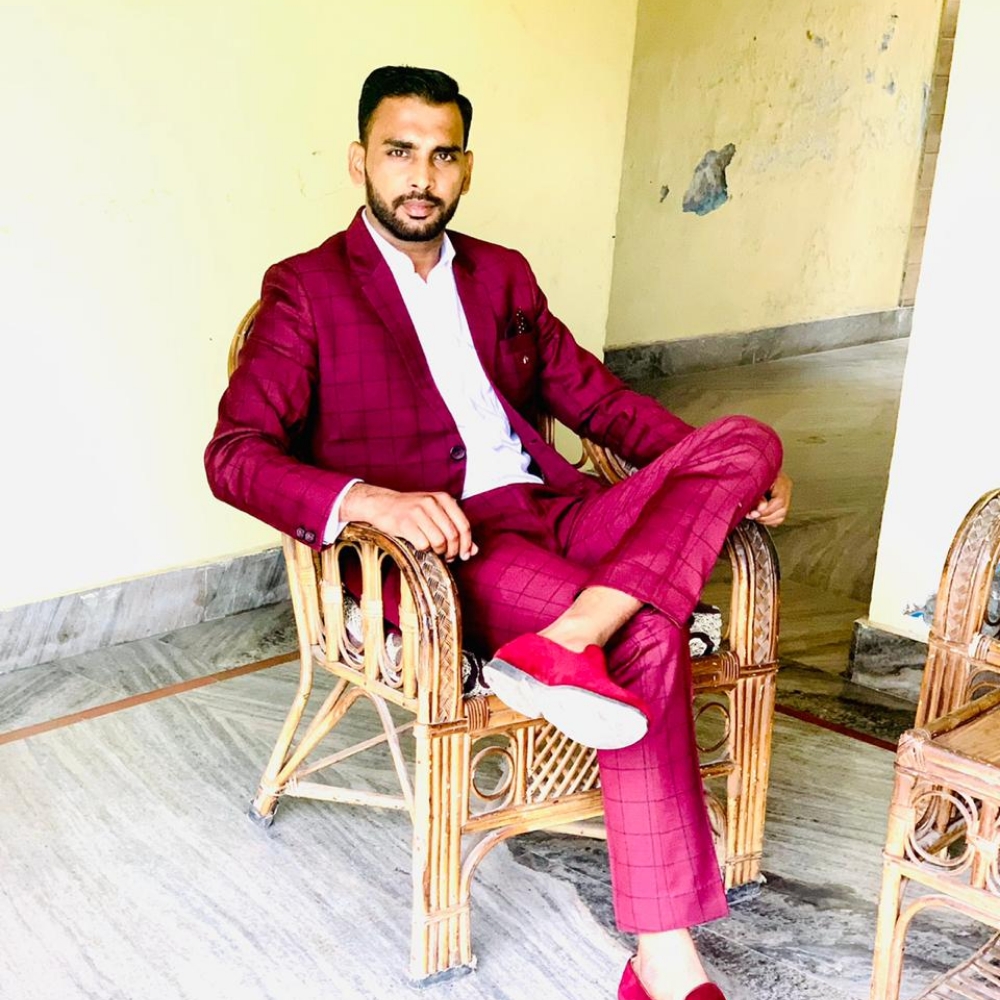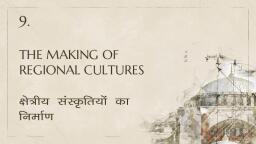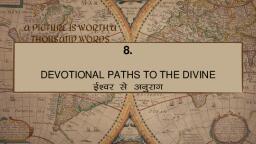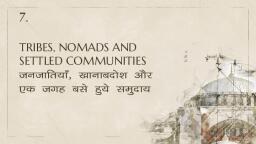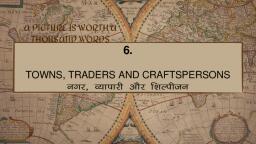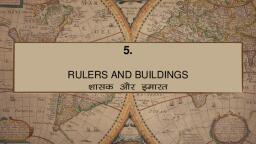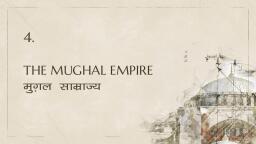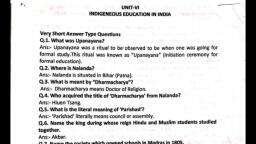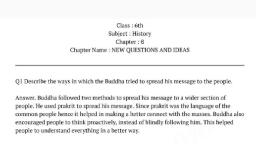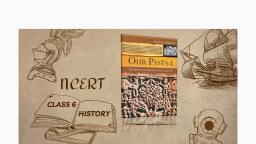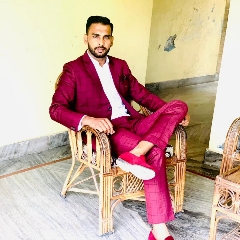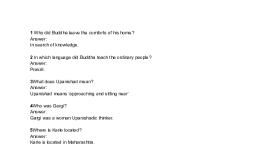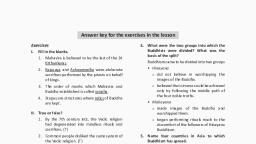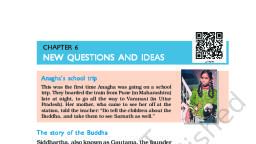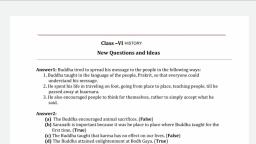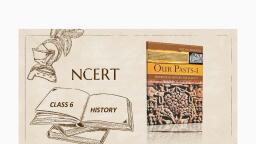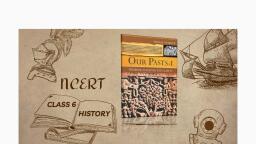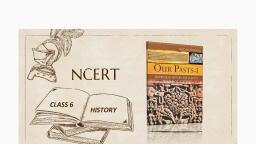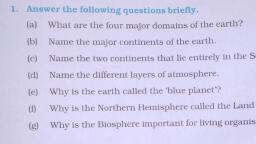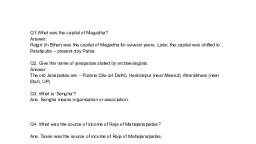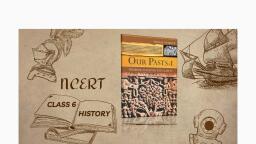Page 2 :
6., NEW QUESTIONS AND, IDEAS
Page 3 :
OVERVIEW, 1. The story of the Buddha, 2. The stupa at Sarnath, 3. The story of Kisagotami, , 4
Page 4 :
The story of the Buddha, ⬗, , Siddhartha, also known as Gautama, the founder of, Buddhism, was born about 2500 years ago., , ⬗, , New cities were developing, and life was changing, in the villages as well, The Buddha belonged to a small gana known as the Sakya, gana, and was a kshatriya. When he was a young man, he left, the comforts of his home in search of knowledge., decided to find his own path to realisation, and meditated for, days on end under a peepal tree at Bodh Gaya in Bihar, where, he attained enlightenment. After that, he was known as the, Buddha or the Wise One., 5, , ⬗
Page 5 :
⬗ He then went to Sarnath, near Varanasi, where he taught for the first time. He, ⬗, ⬗, ⬗, ⬗, 6, , spent the rest of his life travelling on foot, going from place to place, teaching, people, till he passed away at Kusinagra, The Buddha taught that life is full of suffering and unhappiness. This is caused, because we have cravings and desires (which often cannot be fulfilled)., The Buddha described this as thirst or tanha. He taught that this constant, craving could be removed by following moderation in everything., Taught people to be kind, and to respect the lives of others, including animals., He believed that the results of our actions (called karma), whether good or bad,, affect us both in this life and the next., Encouraged people to think for themselves rather than to simply accept what he, said
Page 6 :
The stupa at Sarnath, This building, known as a stupa, was built, to mark the place where the Buddha first, taught his message., The Buddha taught in the language of the, ordinary people, Prakrit, so that everybody, could understand his message., 7
Page 7 :
The story of Kisagotami, Famous story about the Buddha, Woman named Kisagotami, whose son had died., The Buddha said: “Bring me a handful of mustard seeds, and I will, bring your child back to life.” “The seeds must come from the, house of a family where nobody has died.”, she found out that, someone or the other had died, , 8
Page 8 :
Upanishads, ⬗ other thinkers also tried to find answers, , , , , to difficult questions :wanted to know about life after death,, wanted to know why sacrifices should be performed., thinkers felt that there was something permanent in the universe that, would last even after death. They described this as the atman or the, individual soul and the brahman or the universal soul., They believed that ultimately, both the atman and the brahman were one., Many of their ideas were recorded in the Upanishads. These were part of the, later Vedic texts., , 9
Page 9 :
⬗ Most Upanishadic thinkers were men, especially brahmins and rajas., Occasionally, there is mention of women thinkers, such as Gargi, who was, famous for her learning, and participated in debates held in royal courts., ⬗ Poor people rarely took part in these discussions., ⬗ One famous exception was Satyakama Jabala, who was named after his mother,, the slave woman Jabali. He had a deep desire to learn about reality, was accepted, as a student by a brahmin teacher named Gautama,, and became one of the best-known thinkers of the, time. Many of the ideas of the Upanishads were later, developed by the famous thinker Shankaracharya,, , 10
Page 10 :
THE WISE BEGGAR, ⬗ Based on a story from one of the most famous, Upanishads, the Chhandogya Upanishad., ⬗ Shaunaka and Abhipratarin were two sages who, worshipped the universal soul, BEGGAR SAID :- “Then, O sages, by not giving, me food, you are actually denying food to the, universal soul.”, The sages realised the truth of what the beggar, said, and shared their food with him., 11
Page 11 :
Panini, the grammarian, Panini, who prepared a grammar for Sanskrit. He arranged the, , vowels and the consonants in a special order, and then used these, to create formulae like those found in, Algebra., He used these to write down the rules of, , the language in short formulae (around, 3000 of them!)., 12
Page 12 :
Jainism, The last and 24th tirthankara of the Jainas,, Vardhamana Mahavira, also spread his message, around this time, i.e. 2500 years ago. He was a, kshatriya prince of the Lichchhavis, a group that was, part of the Vajji sangha., At the age of thirty, he left home and went to live in a forest. For twelve years, he led a hard and lonely life, at the end of which he attained enlightenment., , 13
Page 13 :
Jainism, He taught a simple doctrine:, men and women who wished to know the truth must leave their homes. They, must follow very strictly the rules of ahimsa, which means not hurting or, killing living beings., “All beings,” said Mahavira “long to live. To all things life is dear.”, Used Prakrit (Prakrit spoken in Magadha was known as Magadhi), , 14
Page 14 :
Followers of Mahavira, who were known as Jainas, had to, lead very simple lives, begging for food. They had to be, absolutely honest, and were especially asked not to steal. Also,, they had to observe celibacy. And men had to give up everything,, including their clothes., Jainism was supported mainly by traders. Farmers, who had to, kill insects to protect their crops, found it more difficult to follow the rules., Over hundreds of years, Jainism spread to different parts of north India, and to, Gujarat, Tamil Nadu and Karnataka., 15
Page 15 :
The teachings were written down in the form in which they are, , presently available at a place called Valabhi, in Gujarat, about 1500, years ago ., , 16
Page 16 :
The sangha, Both the Mahavira and the Buddha felt that only those who left their homes, could gain true knowledge. They arranged for them to stay together in the, sangha, an association of those who left their homes., , 17
Page 17 :
The rules made for the Buddhist sangha were written down in a book called the Vinaya, Pitaka., , From this we know that there were separate branches for men and women., All men could join the sangha., Children had to take the permission of their parents and slaves that of their masters., Those who worked for the king had to take his permission and debtors that of creditors., Women had to take their husbands’ permission., , Men and women who joined the sangha led simple lives., They meditated for most of the time, and went to cities and villages to beg for food, during fixed hours. That is why they were known as bhikkhus (the Prakrit word for, renouncer — beggar). and bhikkhunis., 18
Page 18 :
They taught others, and helped one another., They also held meetings to settle any quarrels that took place within the sangha., Those who joined the sangha included :, brahmins,, kshatriyas,, merchants, labourers, barbers, courtesans and, slaves., Many of them wrote down the teachings of the Buddha. Some of them also, composed beautiful poems, describing their life in the sangha, 19
Page 19 :
Monasteries, As time went on, many supporters of the monks and nuns, and they, themselves, felt the need for more permanent shelters and so monasteries were, built., Earliest viharas were made of wood, and then of brick. Some were even in caves, that were dug out in hills, especially in western India, Very often, the land on which the vihara was built was donated by a rich, merchant or a landowner, or the king. The local people came with gifts of, food, clothing and medicines for the monks and nuns. In return, they taught, the people., 20
Page 20 :
A cave hollowed out in the hills. This is a cave in Karle,, , present-day, Maharashtra., Monks and nuns lived, , and meditated in these, shelters., 21
Page 21 :
The system of ashramas, Brahmins developed the system of ashramas. Here, the word ashrama does not, mean a place where people live and meditate. It is used instead for a stage of life, Four ashramas were recognised:, brahmacharya, grihastha, vanaprastha and samnyasa., 1., 2., 3., 4., 22, , Brahmin, kshatriya and vaishya men were expected to lead simple lives and, study the Vedas during the early years of their life (BRAHMACHARYA)., Then they had to marry and live as householders (GRIHASTHA)., Then they had to live in the forest and meditate (VANAPRASTHA)., Finally, they had to give up everything and become (SAMNYASINS).
Page 22 :
The system of ashramas, The system of ashramas allowed men to spend some part of their lives in, meditation. Generally, women were not allowed to study the Vedas, and they, had to follow the ashramas chosen by their husbands ., , 23
Page 23 :
IRAN, Zoroaster was an Iranian prophet. His teachings are contained in a book called, the Avesta., The language of the Avesta, and the practices described in it are very similar to, those of the Vedas., The basic teachings of Zoroaster are contained in the maxim “Good thoughts,, Good Words and Good Deeds.”, Here is a verse from the Zend Avesta:, “Lord, grant strength and the rule of truth and good thinking, by means of, which one shall create peace and tranquillity.”, 24
Page 24 :
For more than a thousand years, Zoroastrianism was a major religion in Iran., Later, some Zoroastrians migrated from Iran and settled down in the coastal, towns of Gujarat and Maharashtra., They were the ancestors of today’s, Parsis., , 25
Page 25 :
6 SCHOOLS OF PHILOSOPHY, , 26
Page 26 :
27
Page 27 :
TAKEAWAYS, , TRUE OR FALSE :(a) The Buddha encouraged animal sacrifices., (b) Sarnath is important because it was the place where the, Buddha taught for the first time., (c) The Buddha taught that karma has no effect on our, lives., (d) The Buddha attained enlightenment at Bodh Gaya.
Page 28 :
Thanks!, , 29
